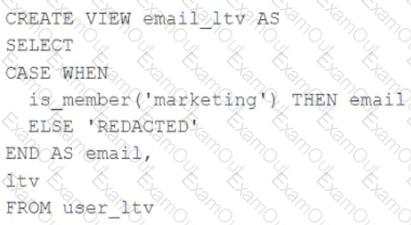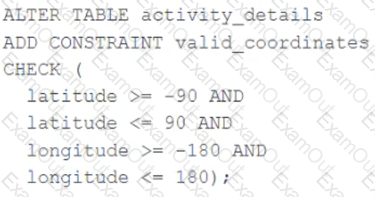A data engineer is performing a join operating to combine values from a static userlookup table with a streaming DataFrame streamingDF.
Which code block attempts to perform an invalid stream-static join?
A Data engineer wants to run unit’s tests using common Python testing frameworks on python functions defined across several Databricks notebooks currently used in production.
How can the data engineer run unit tests against function that work with data in production?
The following code has been migrated to a Databricks notebook from a legacy workload:

The code executes successfully and provides the logically correct results, however, it takes over 20 minutes to extract and load around 1 GB of data.
Which statement is a possible explanation for this behavior?
A table nameduser_ltvis being used to create a view that will be used by data analysts on various teams. Users in the workspace are configured into groups, which are used for setting up data access using ACLs.
Theuser_ltvtable has the following schema:
email STRING, age INT, ltv INT
The following view definition is executed:

An analyst who is not a member of the marketing group executes the following query:
SELECT * FROM email_ltv
Which statement describes the results returned by this query?
When scheduling Structured Streaming jobs for production, which configuration automatically recovers from query failures and keeps costs low?
The data governance team is reviewing code used for deleting records for compliance with GDPR. They note the following logic is used to delete records from the Delta Lake table namedusers.

Assuming thatuser_idis a unique identifying key and thatdelete_requestscontains all users that have requested deletion, which statement describes whether successfully executing the above logic guarantees that the records to be deleted are no longer accessible and why?
A junior data engineer has configured a workload that posts the following JSON to the Databricks REST API endpoint2.0/jobs/create.

Assuming that all configurations and referenced resources are available, which statement describes the result of executing this workload three times?
A CHECK constraint has been successfully added to the Delta table named activity_details using the following logic:

A batch job is attempting to insert new records to the table, including a record where latitude = 45.50 and longitude = 212.67.
Which statement describes the outcome of this batch insert?
The data engineering team maintains a table of aggregate statistics through batch nightly updates. This includes total sales for the previous day alongside totals and averages for a variety of time periods including the 7 previous days, year-to-date, and quarter-to-date. This table is namedstore_saies_summaryand the schema is as follows:

The tabledaily_store_salescontains all the information needed to updatestore_sales_summary. The schema for this table is:
store_id INT, sales_date DATE, total_sales FLOAT
Ifdaily_store_salesis implemented as a Type 1 table and thetotal_salescolumn might be adjusted after manual data auditing, which approach is the safest to generate accurate reports in thestore_sales_summarytable?
A data engineer wants to create a cluster using the Databricks CLI for a big ETL pipeline. The cluster should havefive workers,one driverof type i3.xlarge, and should use the '14.3.x-scala2.12' runtime.
Which command should the data engineer use?

